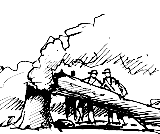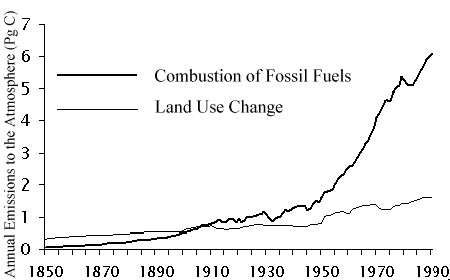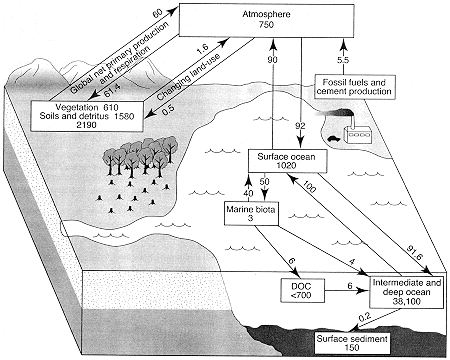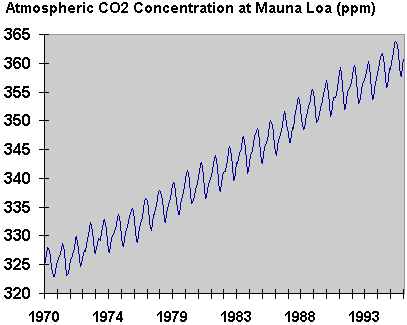|
|
 If the
global totals for photosynthesis and respiration are not equal, carbon
either accumulates on land or is released to the atmosphere.
Unfortunately, the global rates of photosynthesis and respiration are
neither known nor measured well enough to determine annual changes in
carbon storage. On the other hand, human use of the land, for example
the clearing of forests for croplands, is relatively well documented,
both historically and with satellites, and thus can be used to determine
changes in the storage of carbon. If the
global totals for photosynthesis and respiration are not equal, carbon
either accumulates on land or is released to the atmosphere.
Unfortunately, the global rates of photosynthesis and respiration are
neither known nor measured well enough to determine annual changes in
carbon storage. On the other hand, human use of the land, for example
the clearing of forests for croplands, is relatively well documented,
both historically and with satellites, and thus can be used to determine
changes in the storage of carbon.
 Research
at the Center has focused on the current and historic releases of carbon
that result from changes in land use. The
approach we use is based on the fact that much of the carbon stored in
trees and soils is released to the atmosphere when forests are cleared
and cultivated. Some of the release occurs rapidly with burning; some of
it occurs slowly as dead plant material decomposes. When forests regrow
on cleared land, they withdraw carbon from the atmosphere and store it
again in trees and soils. The difference between the total amount of
carbon released to the atmosphere and the total amount withdrawn from
the atmosphere determines whether the land is a net source or sink for
atmospheric carbon. Our approach is thus based on two types of data:
rates of land-use change (e.g., annual rates of deforestation) and the
changes in carbon that follow changes in land use. Research
at the Center has focused on the current and historic releases of carbon
that result from changes in land use. The
approach we use is based on the fact that much of the carbon stored in
trees and soils is released to the atmosphere when forests are cleared
and cultivated. Some of the release occurs rapidly with burning; some of
it occurs slowly as dead plant material decomposes. When forests regrow
on cleared land, they withdraw carbon from the atmosphere and store it
again in trees and soils. The difference between the total amount of
carbon released to the atmosphere and the total amount withdrawn from
the atmosphere determines whether the land is a net source or sink for
atmospheric carbon. Our approach is thus based on two types of data:
rates of land-use change (e.g., annual rates of deforestation) and the
changes in carbon that follow changes in land use.
 Our
work shows that between 1850 and 1990 about 100 Pg of carbon were
released to the atmosphere from changes in land use, worldwide (one Pg
[petagram] = one billion metric tonnes = 1000 x one billion kg). The
amount released each year generally increased over the period, and by
the 1980s the rate of release averaged 1.6 Pg of carbon per year. Our
work shows that between 1850 and 1990 about 100 Pg of carbon were
released to the atmosphere from changes in land use, worldwide (one Pg
[petagram] = one billion metric tonnes = 1000 x one billion kg). The
amount released each year generally increased over the period, and by
the 1980s the rate of release averaged 1.6 Pg of carbon per year.
 When
considered with the other terms in the global carbon equation (the
atmosphere, fossil fuels, and the oceans), there is an apparent
imbalance in the global accounting, and considerable effort has gone
into explaining and finding this residual sink, or
missing sink, of carbon. When
considered with the other terms in the global carbon equation (the
atmosphere, fossil fuels, and the oceans), there is an apparent
imbalance in the global accounting, and considerable effort has gone
into explaining and finding this residual sink, or
missing sink, of carbon. |








